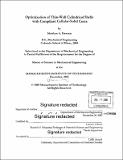Optimization of thin-wall cylindrical shells with compliant cellular-solid cores
Author(s)
Dawson, Matthew A. (Matthew Aaron), 1983-
DownloadFull printable version (10.49Mb)
Other Contributors
Massachusetts Institute of Technology. Dept. of Mechanical Engineering.
Advisor
Lorna J. Gibson.
Terms of use
Metadata
Show full item recordAbstract
Thin-wall, cylindrical structures are found extensively in both engineering components and in nature. Minimum weight design of such structures is essential in a variety of engineering applications, including space shuttle fuel tanks, aircraft fuselages, and offshore oil platforms. In nature, thin-wall cylindrical structures are often supported by a honeycomb- or foam-like cellular core, as for example, in plant stems, porcupine quills, or hedgehog spines. Previous studies have suggested that a compliant core increases the elastic buckling resistance of a cylindrical shell over that of a hollow cylinder of the same weight. In this thesis, we extend the linear-elastic buckling theory by coupling basic plasticity theory to provide a more comprehensive analysis of isotropic, cylindrical shells with compliant cores. This thesis examines the minimum weight design of a thin-wall cylinder with a compliant core, of given radius and specified materials, subjected to a prescribed load in uniaxial compression or pure bending. The analysis gives the values of the shell thickness, the core thickness, and the core density that minimize the weight of the structure for both loading scenarios. (cont.) The weight optimization of the structure identifies the optimum ratio of the core modulus to the shell modulus and is supported by a Lagrangian optimization technique. The design of natural, thin-wall structures with cellular cores is compared to the analytical optimal, and the deviation about the theoretical optimum is explored. The analysis also discusses the selection of materials in the design of the cylinders with compliant cores, identifying the most suitable material combinations. The performance of a cylinder with a compliant core is compared with competing designs (optimized hat-stiffened shell and optimized sandwich-wall shell). Furthermore, experiments comparing the performance of a cylindrical shell with a compliant core to that of an equivalent hollow shell are performed in uniaxial compression; the experimental results supporting the analysis are presented, demonstrating significant improvement over the equivalent hollow shells. Finally, the challenges associated with achieving the optimal design in practice are discussed, and the potential for practical implementation is explored.
Description
Thesis (S.M.)--Massachusetts Institute of Technology, Dept. of Mechanical Engineering, February 2006. Vita. Includes bibliographical references (p. 101-102).
Date issued
2006Department
Massachusetts Institute of Technology. Department of Mechanical EngineeringPublisher
Massachusetts Institute of Technology
Keywords
Mechanical Engineering.